The Visitation
Today is the Church festival commemorating the Visitation of the Blessed Virgin Mary to her cousin Elizabeth. Aardvark Alley outlines the account from Saint Luke and makes a few observations on the occasion.
† Theological musings and answers to selected questions by a confessional Lutheran pastor.
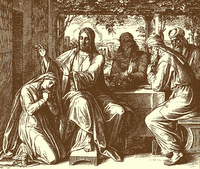 A: The “seal of the confessional” is a guarantee that sins confessed to a minister of the Gospel will never be divulged at any other place. Most pastors extend this confidentiality to anything else said in their presence. Of course, this may occasionally set a pastor at odds with the law of the land, which in some cases mandates that certain suspected or confessed crimes must be reported by those who discover the truth. Many of us have seen news items or read or viewed fictional books and movies in which clergy members are jailed because they refuse to violate either formal oath or an implied unbreakable trust relationship.
A: The “seal of the confessional” is a guarantee that sins confessed to a minister of the Gospel will never be divulged at any other place. Most pastors extend this confidentiality to anything else said in their presence. Of course, this may occasionally set a pastor at odds with the law of the land, which in some cases mandates that certain suspected or confessed crimes must be reported by those who discover the truth. Many of us have seen news items or read or viewed fictional books and movies in which clergy members are jailed because they refuse to violate either formal oath or an implied unbreakable trust relationship.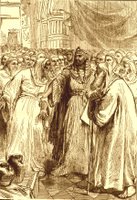 While Scripture doesn’t mention his betrayer by name, the Aramaic Psalms Targum specifies that David wrote about Ahithophel, who later committed suicide. You can read the history behind the Psalm in 2 Samuel 16:15-17:23.
While Scripture doesn’t mention his betrayer by name, the Aramaic Psalms Targum specifies that David wrote about Ahithophel, who later committed suicide. You can read the history behind the Psalm in 2 Samuel 16:15-17:23. A: When I was in elementary school in the 1960s, public school prayer was still common. The U. S. Constitution’s so-called “Establishment Clause” still was understood to mean that the state should not interfere with the churches, not that churches should have no say in affairs of state. (Indeed, when first adopted, this portion of the First Amendment specifically applied only to the Federal Government — many of the original states had established, state-sanctioned churches.) The Supreme Court later reinterpreted this basic law, essentially saying that church and state should be almost completely divorced.
A: When I was in elementary school in the 1960s, public school prayer was still common. The U. S. Constitution’s so-called “Establishment Clause” still was understood to mean that the state should not interfere with the churches, not that churches should have no say in affairs of state. (Indeed, when first adopted, this portion of the First Amendment specifically applied only to the Federal Government — many of the original states had established, state-sanctioned churches.) The Supreme Court later reinterpreted this basic law, essentially saying that church and state should be almost completely divorced.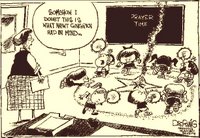 The public schools are not there to give Christians a captive audience for evangelism. We certainly wouldn’t like to live in a non-Christian land and be forced to participate or sit through school prayers to Allah, Vishnu, or other false gods. We would rightly cry out that the schools are there to educate about all things possible without favoring another faith above our own. We would say, “Do it on your own time, not on school time.”
The public schools are not there to give Christians a captive audience for evangelism. We certainly wouldn’t like to live in a non-Christian land and be forced to participate or sit through school prayers to Allah, Vishnu, or other false gods. We would rightly cry out that the schools are there to educate about all things possible without favoring another faith above our own. We would say, “Do it on your own time, not on school time.” Such an educational opportunity for my children helped me decide accept the call to my present congregation. One of my daughters has already graduated from Saint Paul Lutheran High School in Concordia, Missouri and the other just completed her elementary education here at Holy Cross and will enter Saint Paul in the fall. In such an environment, they learn that God, not random chance brought all that is into being and that God is an active, although often hidden, participant in human history and all affairs of the cosmos.
Such an educational opportunity for my children helped me decide accept the call to my present congregation. One of my daughters has already graduated from Saint Paul Lutheran High School in Concordia, Missouri and the other just completed her elementary education here at Holy Cross and will enter Saint Paul in the fall. In such an environment, they learn that God, not random chance brought all that is into being and that God is an active, although often hidden, participant in human history and all affairs of the cosmos. A: Not all of our divisions are according to the Christian calendar. The new year and our division of months comes from the Roman calendar. So do the names of the months. Our day names come from German-Nordic and Roman sources.
A: Not all of our divisions are according to the Christian calendar. The new year and our division of months comes from the Roman calendar. So do the names of the months. Our day names come from German-Nordic and Roman sources.13. But when Jesus had finished His course of patient endurance, and had redeemed mankind from their sins, He ascended again into the heavens, a cloud receiving Him up: and as He went up Angels were beside Him, and Apostles were beholding. But if any man disbelieves the words which I speak, let him believe the actual power of the things now seen. All kings when they die have their power extinguished with their life: but Christ crucified is worshiped by the whole world. We proclaim The Crucified, and the devils tremble now. Many have been crucified at various times; but of what other who was crucified did the invocation ever drive the devils away?
14. Let us, therefore, not be ashamed of the Cross of Christ; but though another hide it, do thou openly seal it upon thy forehead, that the devils may behold the royal sign and flee trembling far away. Make then this sign at eating and drinking, at sitting, at lying down, at rising up, at speaking, at walking: in a word, at every act. For He who was here crucified is in heaven above. If after being crucified and buried He had remained in the tomb, we should have had cause to be ashamed; but, in fact, He who was crucified on Golgotha here, has ascended into heaven from the Mount of Olives on the East. For after having gone down hence into Hades, and come up again to us, He ascended again from us into heaven, His Father addressing Him, and saying, “Sit at my right hand, until I make your enemies your footstool.”
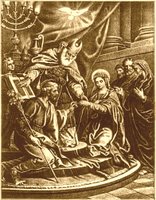 Regarding marriage, God never set it as an absolute command. As I said previously, “He instituted marriage. He blesses marriage. He provides marriage for all who desire familial companionship, sex, and children. However, Jesus transcends these things. Earthly marriage is, in large part, for procreation. Jesus didn’t come to earth to have children. Instead, He came to make children for His Father.”
Regarding marriage, God never set it as an absolute command. As I said previously, “He instituted marriage. He blesses marriage. He provides marriage for all who desire familial companionship, sex, and children. However, Jesus transcends these things. Earthly marriage is, in large part, for procreation. Jesus didn’t come to earth to have children. Instead, He came to make children for His Father.”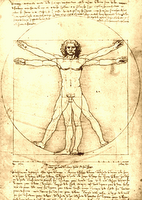 A: Like many a good lie, there’s a very small kernel of truth contained within. Since a recent essay from Aardvark Alley dealt with this question, I include portions of it (with permission) in my response.
A: Like many a good lie, there’s a very small kernel of truth contained within. Since a recent essay from Aardvark Alley dealt with this question, I include portions of it (with permission) in my response.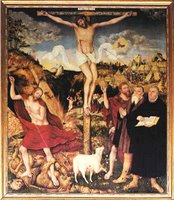 His other possible conclusion “is that Luther was speaking theologically [specifically, Christologically]. Talking with, granting forgiveness to, and allowing anointing by these women was emblematic of Jesus’ entire earthly ministry.... While sinless, He took our sins upon Himself that He might fully forgive us. Paul summarized this work in 2 Corinthians 5:21, saying, ‘For our sake [God] made him to be sin who knew no sin, so that in him we might become the righteousness of God.’
His other possible conclusion “is that Luther was speaking theologically [specifically, Christologically]. Talking with, granting forgiveness to, and allowing anointing by these women was emblematic of Jesus’ entire earthly ministry.... While sinless, He took our sins upon Himself that He might fully forgive us. Paul summarized this work in 2 Corinthians 5:21, saying, ‘For our sake [God] made him to be sin who knew no sin, so that in him we might become the righteousness of God.’ A: None of my resources go into any detail as to why this wording is used; only a few even note the obvious difference in the number of legs. Thus, I’m forced to offer an educated guess. Since these are being compared with various other clean and unclean animals, I take “all fours” to stand for walking bugs as opposed to those that crawl about. This could come from the fact that many walking insects have two hopping legs that might be are considered separately from the other four.
A: None of my resources go into any detail as to why this wording is used; only a few even note the obvious difference in the number of legs. Thus, I’m forced to offer an educated guess. Since these are being compared with various other clean and unclean animals, I take “all fours” to stand for walking bugs as opposed to those that crawl about. This could come from the fact that many walking insects have two hopping legs that might be are considered separately from the other four.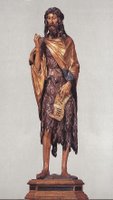 Among this people God set apart, He called a select few to special service. Among these was the most famous “bug eater” in Scripture, John the Baptizer. Along with his “garment of camel’s hair and a leather belt around his waist,” people recognized this special messenger of the coming Christ because of his diet of “locusts and wild honey. (Matthew 3:4)”
Among this people God set apart, He called a select few to special service. Among these was the most famous “bug eater” in Scripture, John the Baptizer. Along with his “garment of camel’s hair and a leather belt around his waist,” people recognized this special messenger of the coming Christ because of his diet of “locusts and wild honey. (Matthew 3:4)”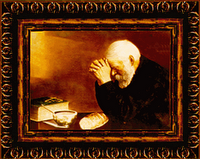 A: Many commentators include a spiritual interpretation of the Fourth Petition in their discussion of the Our Father. I don’t object to this being a part of the understanding of this petition. I disagree when they make it the only allowable interpretation, or even the primary meaning.
A: Many commentators include a spiritual interpretation of the Fourth Petition in their discussion of the Our Father. I don’t object to this being a part of the understanding of this petition. I disagree when they make it the only allowable interpretation, or even the primary meaning.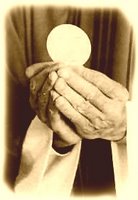 Certainly, the Church has traditionally prayed these words immediately before the Lord’s Supper, as a sort of “table prayer.” The entire prayer must include proper reception of Holy Communion, for the Supper belongs to God’s name, kingdom, and will; it involves physical eating and drinking; it brings forgiveness, guards from evil, and leads us from temptation to God’s truth.
Certainly, the Church has traditionally prayed these words immediately before the Lord’s Supper, as a sort of “table prayer.” The entire prayer must include proper reception of Holy Communion, for the Supper belongs to God’s name, kingdom, and will; it involves physical eating and drinking; it brings forgiveness, guards from evil, and leads us from temptation to God’s truth. A: First of all, remember that “meat” has changed meaning in the English language. Older translations often use it where we would normally say “food.” So it is here. However, whether we say “meat” or “food,” the Lord clearly prescribed a vegetarian diet. Verse 30 extends this beyond humanity; vegetation was also the food given to “every beast of the earth and to every bird of the heavens and to everything that creeps on the earth, everything that has the breath of life.”
A: First of all, remember that “meat” has changed meaning in the English language. Older translations often use it where we would normally say “food.” So it is here. However, whether we say “meat” or “food,” the Lord clearly prescribed a vegetarian diet. Verse 30 extends this beyond humanity; vegetation was also the food given to “every beast of the earth and to every bird of the heavens and to everything that creeps on the earth, everything that has the breath of life.” After the Ark landed, the Lord told Noah, “The fear of you and the dread of you shall be upon every beast of the earth and upon every bird of the heavens, upon everything that creeps on the ground and all the fish of the sea. Into your hand they are delivered. Every moving thing that lives shall be food for you. And as I gave you the green plants, I give you everything. (9:2-3)”
After the Ark landed, the Lord told Noah, “The fear of you and the dread of you shall be upon every beast of the earth and upon every bird of the heavens, upon everything that creeps on the ground and all the fish of the sea. Into your hand they are delivered. Every moving thing that lives shall be food for you. And as I gave you the green plants, I give you everything. (9:2-3)”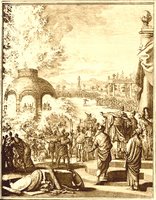 A: The Bible doesn’t tell us for certain, but it appears that it was either an angel or else God Himself — specifically, the Son of God, the preincarnate Christ — taking human form as He came to save His faithful servants. The technical term for such an event is theophany — an appearance of God to man. Even the pagan Nebuchadnezzar recognized the fourth person in the flames with Shadrach, Meshach, and Abednego as “like a son of the gods. (v. 25)”
A: The Bible doesn’t tell us for certain, but it appears that it was either an angel or else God Himself — specifically, the Son of God, the preincarnate Christ — taking human form as He came to save His faithful servants. The technical term for such an event is theophany — an appearance of God to man. Even the pagan Nebuchadnezzar recognized the fourth person in the flames with Shadrach, Meshach, and Abednego as “like a son of the gods. (v. 25)” A: Building towers above churches obviously occurred after Christianity became a “legal” religion and began in earnest around AD 600. The practice seemingly came from military architecture. Before that time, Christians took great pains to divert attention from their gathering places. Once special houses of worship came into being, various projections started to arise from them. The use of elaborate towers developed in medieval times. From these came our modern steeples.
A: Building towers above churches obviously occurred after Christianity became a “legal” religion and began in earnest around AD 600. The practice seemingly came from military architecture. Before that time, Christians took great pains to divert attention from their gathering places. Once special houses of worship came into being, various projections started to arise from them. The use of elaborate towers developed in medieval times. From these came our modern steeples.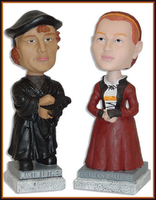 True submission is not the abandonment of self as much as it is the realization of self in the person and life of another. The wife to her husband — as the Church to Christ — submits in obedience — not blindly, but with eyes wide open. The Church knows that heeding and obeying her Savior’s words is the greatest love she can return to Him. So also the Christian wife knows that her greatest gift of love to her husband is to allow him to occupy the divinely ordained headship of the family. In her submission, she models the relationship that the Church has with Jesus.
True submission is not the abandonment of self as much as it is the realization of self in the person and life of another. The wife to her husband — as the Church to Christ — submits in obedience — not blindly, but with eyes wide open. The Church knows that heeding and obeying her Savior’s words is the greatest love she can return to Him. So also the Christian wife knows that her greatest gift of love to her husband is to allow him to occupy the divinely ordained headship of the family. In her submission, she models the relationship that the Church has with Jesus.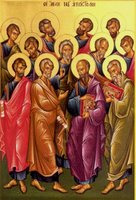 A: Didache is Greek for “Teaching.” The full title of this brief compilation is The Teaching of the Lord to the Gentiles by the Twelve Apostles. While some dispute its antiquity or authenticity, a large number of Christian scholars and historians believe that the Didache, a Syrian Christian document, was written around AD 100, perhaps several years earlier.
A: Didache is Greek for “Teaching.” The full title of this brief compilation is The Teaching of the Lord to the Gentiles by the Twelve Apostles. While some dispute its antiquity or authenticity, a large number of Christian scholars and historians believe that the Didache, a Syrian Christian document, was written around AD 100, perhaps several years earlier. A: Let’s make sure we understand our terms before continuing. “Sanctify” and “sanctification” stem from the same Scriptural root words often translated as “holy” and “holiness.” Ultimately, this state of being only applies to God. Only He is completely without sin, incapable of sinning, and absolutely hating sin. Regarding Christians, it comes to us extra nos (from outside ourselves) as both a forensic declaration and as a Spirit-worked changing of our hearts. However, we need more than just a dictionary definition; we need to know what God considers holy as much as knowing what makes us holy and how we act in a holy manner.
A: Let’s make sure we understand our terms before continuing. “Sanctify” and “sanctification” stem from the same Scriptural root words often translated as “holy” and “holiness.” Ultimately, this state of being only applies to God. Only He is completely without sin, incapable of sinning, and absolutely hating sin. Regarding Christians, it comes to us extra nos (from outside ourselves) as both a forensic declaration and as a Spirit-worked changing of our hearts. However, we need more than just a dictionary definition; we need to know what God considers holy as much as knowing what makes us holy and how we act in a holy manner. Those seeking to increase their own righteousness make themselves into modern Pharisees, moving away from a right relationship with God even as they attempt to approach Him on their own merits. Believing holiness to be primarily a human endeavor, they prescribe various self-disciplines. They focus on self-denial, self-sacrifice, and self-mortification.
Those seeking to increase their own righteousness make themselves into modern Pharisees, moving away from a right relationship with God even as they attempt to approach Him on their own merits. Believing holiness to be primarily a human endeavor, they prescribe various self-disciplines. They focus on self-denial, self-sacrifice, and self-mortification. You cannot desire to do that which is not part of who you are. James asked, “Can a fig tree, my brothers, bear olives, or a grapevine produce figs? (3:12)” Only a holy person thinks holy thoughts or does holy deeds. Bearing “fruit in keeping with repentance (Luke 3:8)” is thinking, saying, and doing what you believe about the One who forgives you. It reveals the indwelling presence of His Holy Spirit.
You cannot desire to do that which is not part of who you are. James asked, “Can a fig tree, my brothers, bear olives, or a grapevine produce figs? (3:12)” Only a holy person thinks holy thoughts or does holy deeds. Bearing “fruit in keeping with repentance (Luke 3:8)” is thinking, saying, and doing what you believe about the One who forgives you. It reveals the indwelling presence of His Holy Spirit.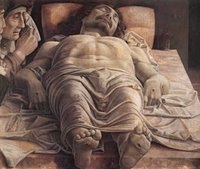 Touching on the final bit of your question, what is “necessary to retain salvation” isn’t doing more and better works. You “retain salvation” as God continually forgives and renews you through Word and Sacrament by the power of His Holy Spirit. You show that you are saved as Christ honors the Father and loves your neighbor through your words and deeds.
Touching on the final bit of your question, what is “necessary to retain salvation” isn’t doing more and better works. You “retain salvation” as God continually forgives and renews you through Word and Sacrament by the power of His Holy Spirit. You show that you are saved as Christ honors the Father and loves your neighbor through your words and deeds.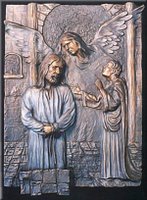 A: The Stations of the Cross remember various stages of the Passion. Some Lutheran, Episcopal, and other churches set them up, although they are most used in Catholicism. I’ve seen several churches that have plaques or the like indoors, but they began as outdoor shrines, where one could “walk with the Savior,” stopping to think and pray at each.
A: The Stations of the Cross remember various stages of the Passion. Some Lutheran, Episcopal, and other churches set them up, although they are most used in Catholicism. I’ve seen several churches that have plaques or the like indoors, but they began as outdoor shrines, where one could “walk with the Savior,” stopping to think and pray at each.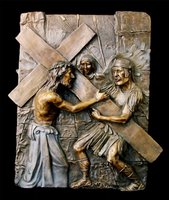 They are most usually arranged at intervals around the walls of a church nave. The traditional Stations trace a path known as the Via Dolorosa (Way of Sorrow) as Jesus was led out from Jerusalem to be crucified.
They are most usually arranged at intervals around the walls of a church nave. The traditional Stations trace a path known as the Via Dolorosa (Way of Sorrow) as Jesus was led out from Jerusalem to be crucified.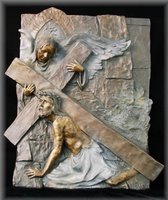 The Stations may be of stone, wood, or metal, sculptured or carved, or they may be painted or engraved. Some are renowned art works, such as those in the cathedral in Antwerp, Belgium.
The Stations may be of stone, wood, or metal, sculptured or carved, or they may be painted or engraved. Some are renowned art works, such as those in the cathedral in Antwerp, Belgium.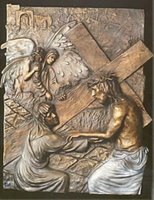 For some time, the number of Stations varied, but fourteen are now prescribed by Roman Catholic authority. As you read about them below, you see that some have Scriptural background, while others are derived from pious fable or myth.
For some time, the number of Stations varied, but fourteen are now prescribed by Roman Catholic authority. As you read about them below, you see that some have Scriptural background, while others are derived from pious fable or myth.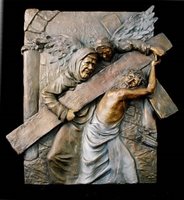 The fourteen accepted by Rome are 1) Christ condemned to death; 2) the cross laid upon Him; 3) His first fall; 4) He meets His mother along the way; 5) Simon of Cyrene is forced to carry the cross; 6) Christ’s face is wiped by Veronica (the origin of the story of the veil that supposedly held the image of His face from that time forward); 7) His second fall; 8) He meets the women of Jerusalem; 9) His third fall; 10) Stripped of His garments; 11) His crucifixion; 12) His death on the cross; 13) His body taken down from the cross; and 14) laid in the tomb. In non-Roman Catholic versions, the multiple falls are usually omitted, as is the Veronica Station.
The fourteen accepted by Rome are 1) Christ condemned to death; 2) the cross laid upon Him; 3) His first fall; 4) He meets His mother along the way; 5) Simon of Cyrene is forced to carry the cross; 6) Christ’s face is wiped by Veronica (the origin of the story of the veil that supposedly held the image of His face from that time forward); 7) His second fall; 8) He meets the women of Jerusalem; 9) His third fall; 10) Stripped of His garments; 11) His crucifixion; 12) His death on the cross; 13) His body taken down from the cross; and 14) laid in the tomb. In non-Roman Catholic versions, the multiple falls are usually omitted, as is the Veronica Station.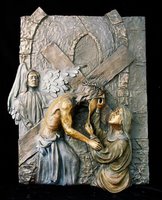 A variant that doesn’t follow these exact steps originated in the Vienna area around the year 1800. Its eleven steps are 1) Agony in the Garden; 2) Betrayal by Judas; 3) Scourging; 4) Crowning with thorns; 5) Christ condemned to death; 6) Meeting Simon of Cyrene; 7) Women of Jerusalem; 8) Tasting the gall; 9) Nailed to the cross; 10) Death on the cross; and 11) His body taken down from the cross. Those uncomfortable with the Roman Catholic insertions of non-Scriptural Stations choose this latter variant or some other format that holds only Biblically attested events.
A variant that doesn’t follow these exact steps originated in the Vienna area around the year 1800. Its eleven steps are 1) Agony in the Garden; 2) Betrayal by Judas; 3) Scourging; 4) Crowning with thorns; 5) Christ condemned to death; 6) Meeting Simon of Cyrene; 7) Women of Jerusalem; 8) Tasting the gall; 9) Nailed to the cross; 10) Death on the cross; and 11) His body taken down from the cross. Those uncomfortable with the Roman Catholic insertions of non-Scriptural Stations choose this latter variant or some other format that holds only Biblically attested events.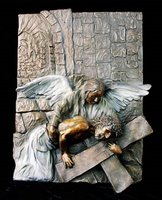 I’ve seen some displays that work a Pietà (a portrayal of the dead Christ in His mother’s arms) into the station where He is removed from the cross.
I’ve seen some displays that work a Pietà (a portrayal of the dead Christ in His mother’s arms) into the station where He is removed from the cross.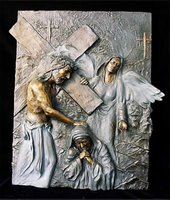 Indoor settings are normally permanently mounted for display and use as devotional aids. This is so for many outdoor Stations also, although some are only displayed during the Lenten season.
Indoor settings are normally permanently mounted for display and use as devotional aids. This is so for many outdoor Stations also, although some are only displayed during the Lenten season.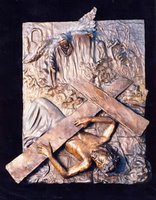 The outdoor arrangement is becoming more common in many parts of the United States. Churches will set them on their lawns, in their parking lots, or elsewhere room permits, often including benches or other seating for those who wish to stop for a time to rest, contemplate, and pray at each Station.
The outdoor arrangement is becoming more common in many parts of the United States. Churches will set them on their lawns, in their parking lots, or elsewhere room permits, often including benches or other seating for those who wish to stop for a time to rest, contemplate, and pray at each Station.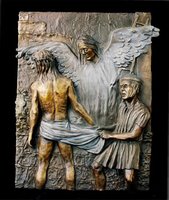 However the stations are displayed, they should not be considered as granting some special spiritual blessing; nor should hosting churches or individuals force visitors to the Stations pray or meditate according to any one set form.
However the stations are displayed, they should not be considered as granting some special spiritual blessing; nor should hosting churches or individuals force visitors to the Stations pray or meditate according to any one set form.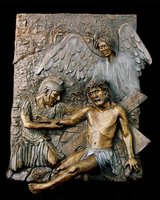 So how does one approach the Stations of the Cross? The simple answer is that Christians should come with faith grounded in the death and resurrection of Jesus as recorded in Holy Scripture.
So how does one approach the Stations of the Cross? The simple answer is that Christians should come with faith grounded in the death and resurrection of Jesus as recorded in Holy Scripture.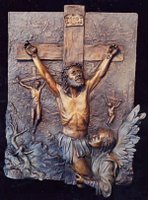 Beyond this, the believer should avoid seeking emotional stimulation. I don’t mean that we view the Stations as zombies. The visual power of the images coupled with the testimony of Scripture will, of course, trigger our emotions but placing emotionalism above edification certainly lessens their spiritual impact.
Beyond this, the believer should avoid seeking emotional stimulation. I don’t mean that we view the Stations as zombies. The visual power of the images coupled with the testimony of Scripture will, of course, trigger our emotions but placing emotionalism above edification certainly lessens their spiritual impact.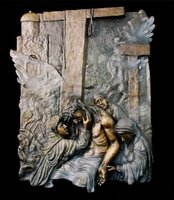 To guard against this, it helps to approach the Stations after having recently read the Scriptural accounts of the Passion or following a sermon on Christ’s suffering and death. Take along prepared prayers, meditate on the Ten Commandments and your failure to keep them, pray the Our Father, and confess the Creed.
To guard against this, it helps to approach the Stations after having recently read the Scriptural accounts of the Passion or following a sermon on Christ’s suffering and death. Take along prepared prayers, meditate on the Ten Commandments and your failure to keep them, pray the Our Father, and confess the Creed.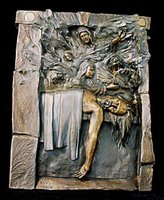 Some people might want to travel the Stations by themselves. This can help them look honestly at their own sins without fearing the judgment of companions. However, others may find greater benefit in going with close friends or family. This allows them to comfort, pray with and for, and forgive each other. It also gives the individuals opportunity to confess their faith with like-minded people, perhaps encouraging them also to be more comfortable sharing their faith with unbelievers.
Some people might want to travel the Stations by themselves. This can help them look honestly at their own sins without fearing the judgment of companions. However, others may find greater benefit in going with close friends or family. This allows them to comfort, pray with and for, and forgive each other. It also gives the individuals opportunity to confess their faith with like-minded people, perhaps encouraging them also to be more comfortable sharing their faith with unbelievers.